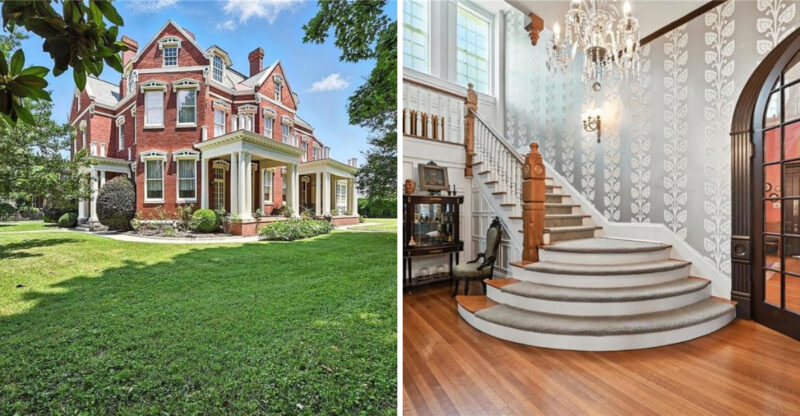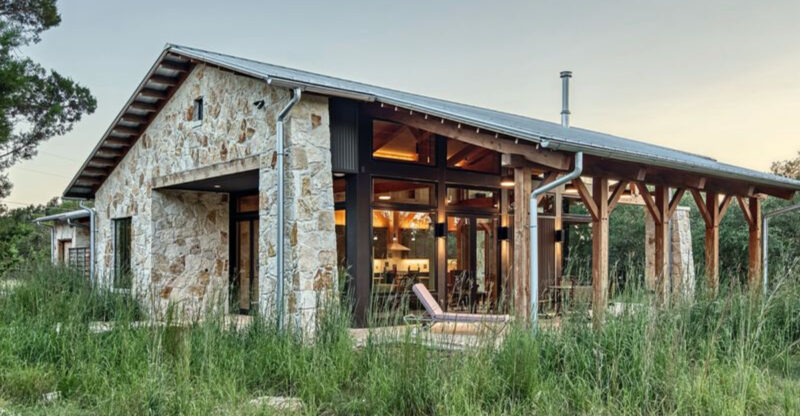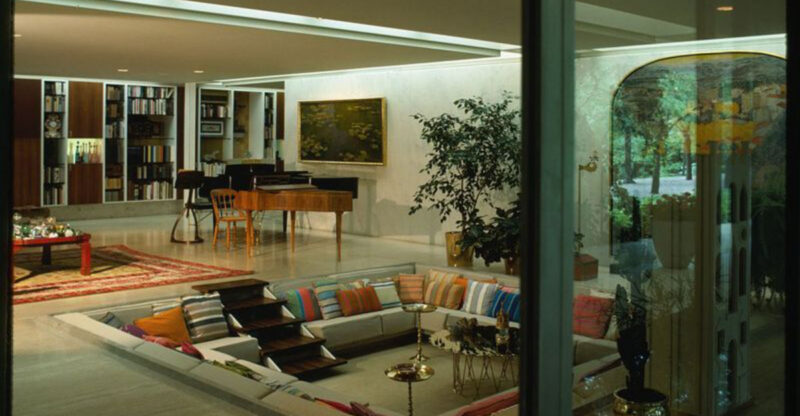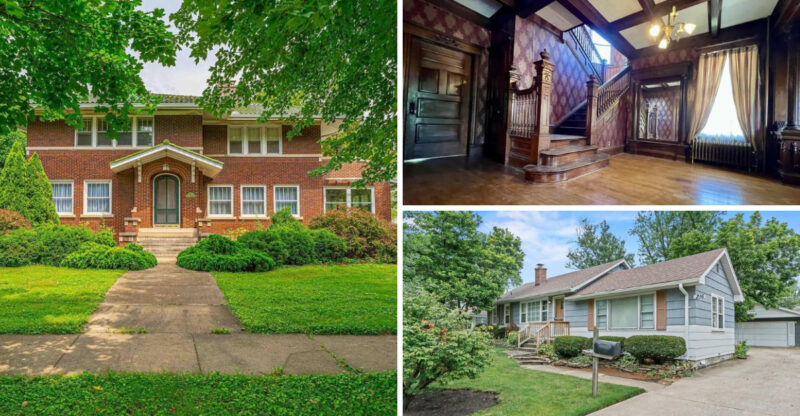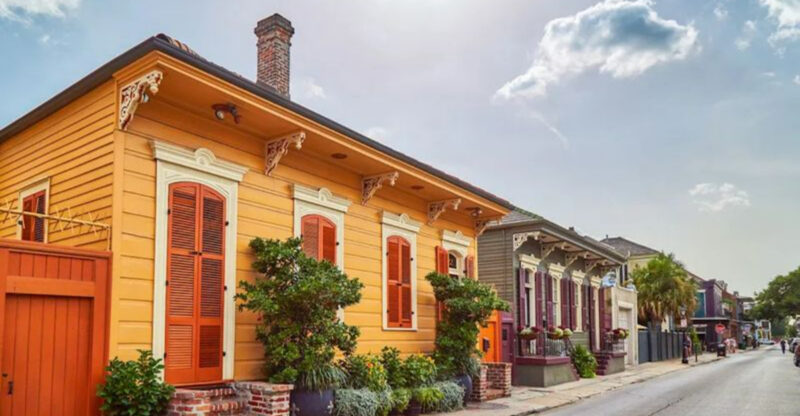16 Historic Homes Across America That Were Once Home To The Country’s Wealthiest
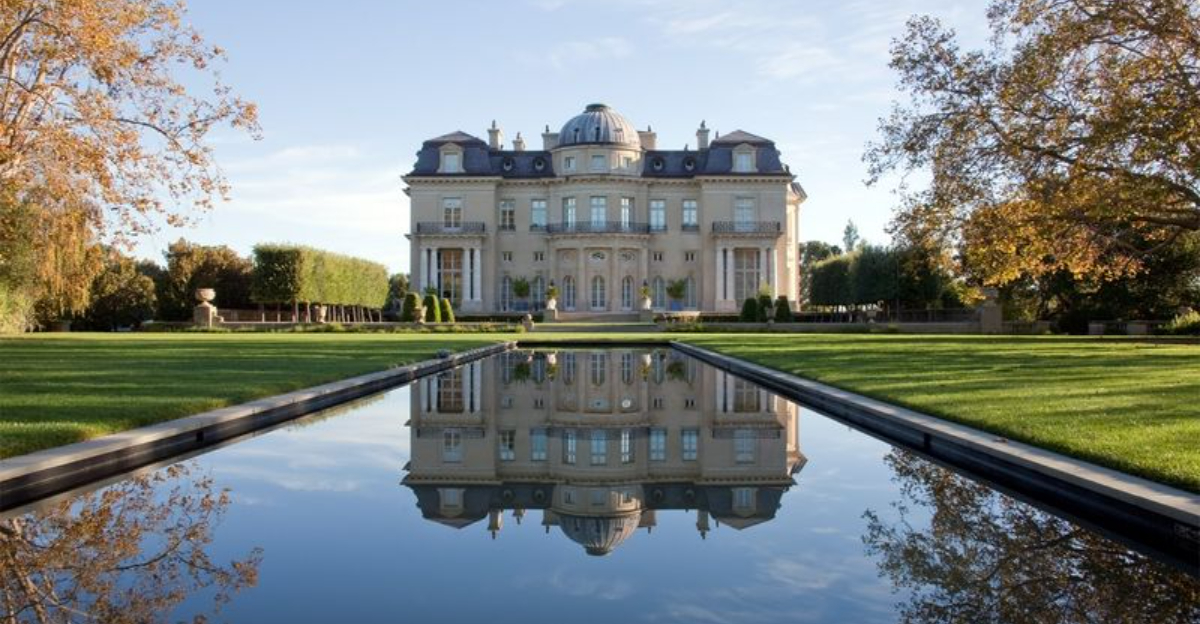
America’s landscape is dotted with magnificent mansions that tell stories of extreme wealth and opulence from bygone eras.
These architectural treasures offer a glimpse into the lives of industrial tycoons, business magnates, and political leaders who shaped our nation’s history.
From sprawling estates with hundreds of rooms to seaside retreats with panoramic ocean views, these historic homes showcase the extravagant lifestyles of America’s wealthiest families during the Gilded Age and beyond.
1. The Breakers – Newport, Rhode Island
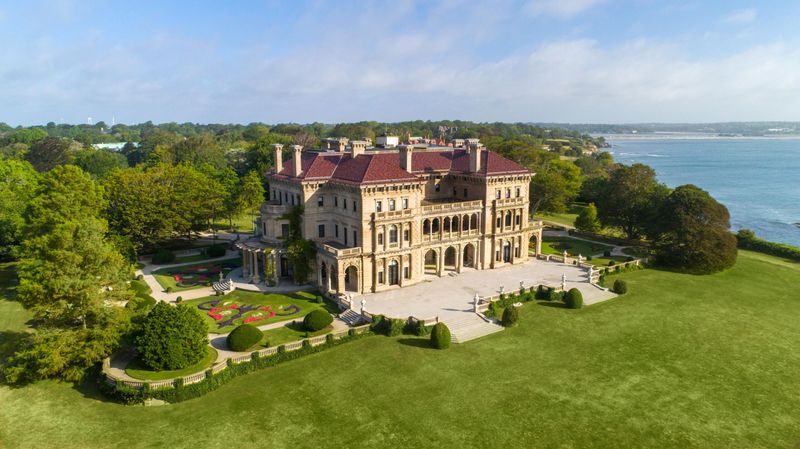
Cornelius Vanderbilt II spared no expense when building this 70-room Italian Renaissance-style palazzo in 1893. The railroad magnate’s summer “cottage” cost a staggering $7 million (equivalent to over $200 million today)!
Walking through The Breakers feels like stepping into European royalty. The Great Hall soars 45 feet high with stunning mosaics and marble columns imported from Africa and Italy. My favorite room is the Morning Room, with platinum leaf wall panels that shimmer in the sunlight.
The Vanderbilt family owned The Breakers until 1972 when the Preservation Society of Newport County purchased it. Now open to the public, it attracts over 400,000 visitors annually who marvel at this symbol of America’s Gilded Age excess.
2. Biltmore Estate – Asheville, North Carolina
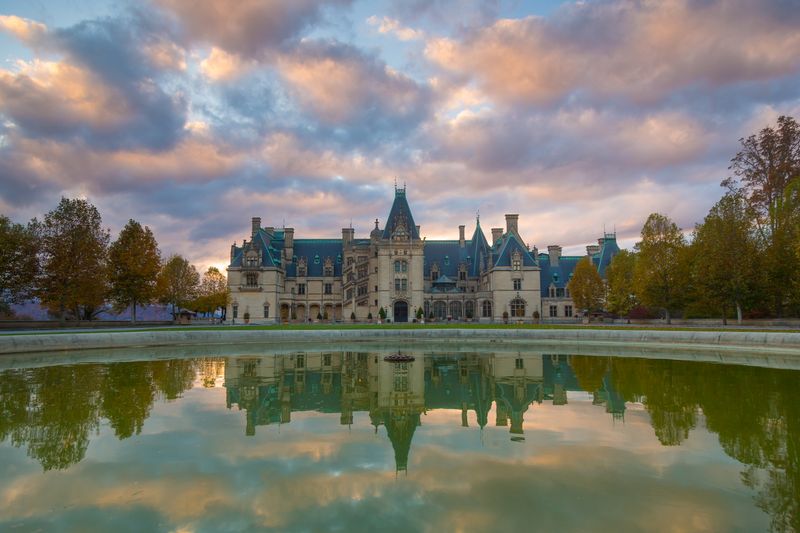
George Washington Vanderbilt II created America’s largest privately-owned house in 1895, spanning an incredible 178,926 square feet with 250 rooms. The French Renaissance château sits on 8,000 acres of meticulously landscaped grounds designed by Frederick Law Olmsted, the genius behind Central Park.
Inside this massive estate, you’ll find 35 bedrooms, 43 bathrooms, and 65 fireplaces. The Banquet Hall features a 70-foot ceiling and a pipe organ, while the library houses over 10,000 volumes. Did you know the indoor swimming pool was filled with heated water – an extraordinary luxury in the 1890s?
Unlike many historic mansions, Biltmore remains in the Vanderbilt family, now operated as a tourist attraction welcoming over 1.4 million visitors yearly.
3. Hearst Castle – San Simeon, California
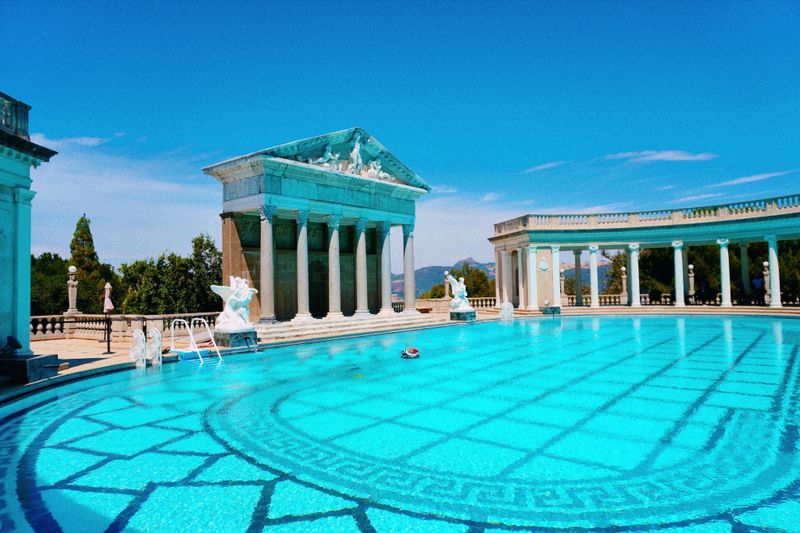
Publishing tycoon William Randolph Hearst collaborated with architect Julia Morgan to build this Mediterranean Revival masterpiece over 28 years. The result? A 115-room main house perched atop “La Cuesta Encantada” (The Enchanted Hill) with breathtaking views of the Pacific Ocean.
Hearst filled his dream home with priceless art and antiquities from around the world. The Neptune Pool, perhaps the estate’s most famous feature, is lined with Vermont marble and adorned with actual Roman temple façades. Hollywood celebrities like Charlie Chaplin, Cary Grant, and Joan Crawford frequently visited this lavish estate for wild weekend parties.
After Hearst’s death in 1951, his family donated the property to California. Today, it operates as a state historic park that has welcomed over 40 million visitors.
4. Vizcaya Museum & Gardens – Miami, Florida
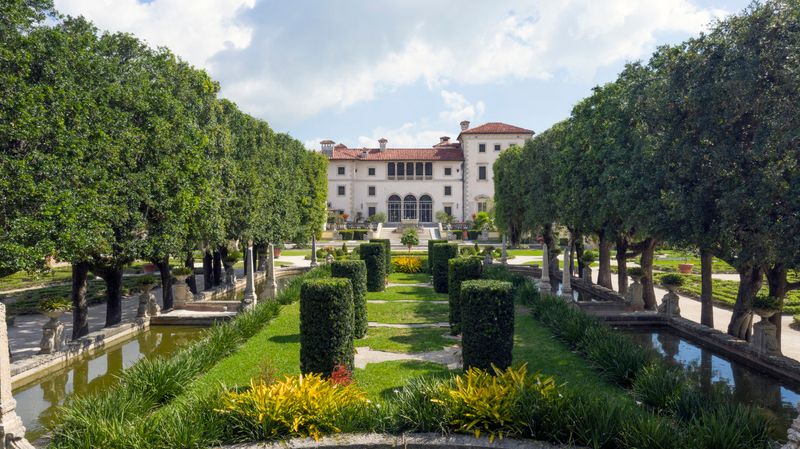
International Harvester Vice President James Deering built this stunning Italian Renaissance-inspired villa between 1914 and 1922 as his winter retreat. The 34-room mansion sits on Biscayne Bay, surrounded by 10 acres of formal gardens that blend Italian and French design with tropical Florida elements.
What makes Vizcaya truly exceptional is how it embraces its waterfront setting. The Stone Barge, a breakwater shaped like an ornate ship, juts into the bay, creating a dramatic first impression for guests arriving by water. Inside, rooms overflow with European antiques spanning 400 years of history.
Deering’s nieces inherited Vizcaya after his death in 1925. They later sold it to Miami-Dade County, which transformed this tropical paradise into a museum that has hosted notable visitors including Queen Elizabeth II and Pope John Paul II.
5. Kykuit – Sleepy Hollow, New York
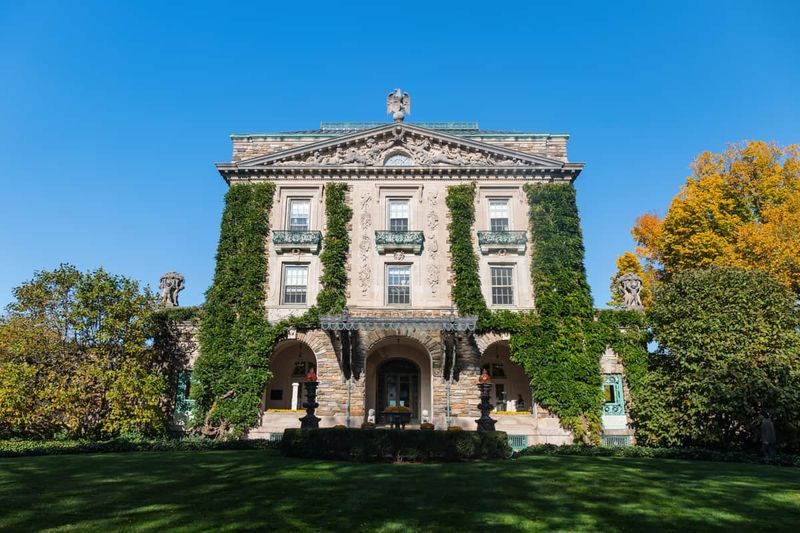
Oil magnate John D. Rockefeller, once the richest man in America, built this six-story stone mansion in 1913 as his family’s country retreat. The name “Kykuit” means “lookout” in Dutch – fitting for an estate perched high above the Hudson River with spectacular views.
Four generations of Rockefellers lived here, each adding their personal touch. Nelson Rockefeller, the 41st Vice President, installed an impressive collection of modern art throughout the property, including works by Picasso, Calder, and Moore. The terraced gardens feature classical sculptures and playful fountains that dance to music.
Though the mansion contains 40 rooms, it feels surprisingly intimate compared to other Gilded Age estates. The underground art galleries, which house Nelson’s prized tapestries, and the climate-controlled coach barn with its collection of rare automobiles and horse-drawn carriages are must-see attractions.
6. Mount Vernon – Mount Vernon, Virginia
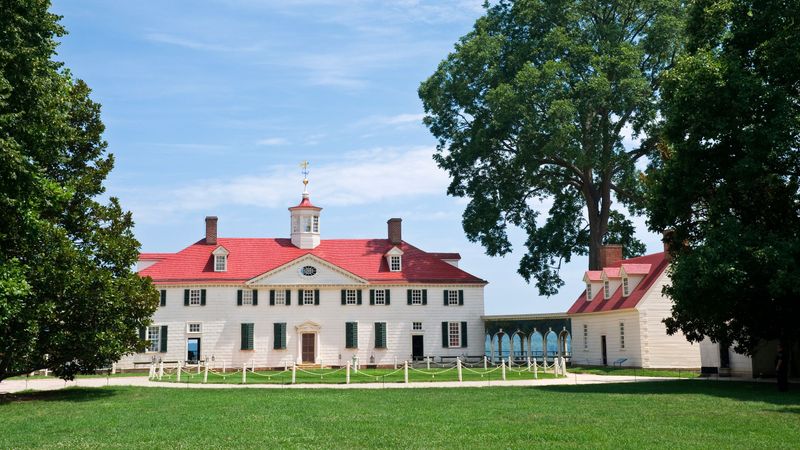
George Washington’s beloved home represents the pinnacle of 18th-century plantation wealth. The first president expanded the original farmhouse into a 21-room mansion overlooking the Potomac River, creating one of America’s earliest grand estates.
Unlike the Gilded Age mansions built with industrial fortunes, Mount Vernon showcases colonial elegance with its iconic two-story piazza and meticulous symmetry. Washington personally supervised every detail, from the distinctive weatherboarding (beveled to resemble stone) to the cupola crowned with a weathervane shaped like a dove of peace.
After Martha Washington’s death in 1802, the estate fell into disrepair until the Mount Vernon Ladies’ Association purchased it in 1858. Their preservation efforts make Mount Vernon America’s most visited historic home, welcoming over 1 million visitors annually who come to experience the birthplace of American presidential grandeur.
7. Monticello – Charlottesville, Virginia
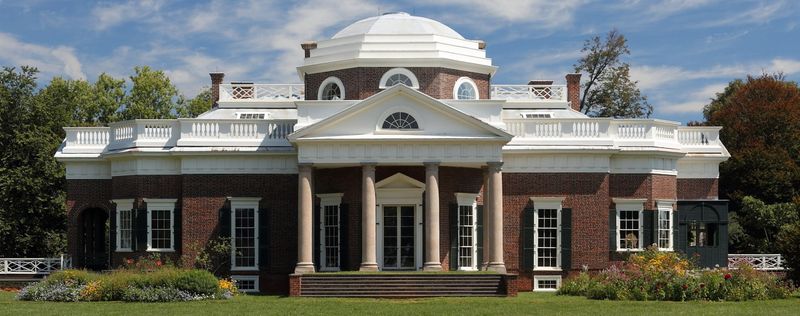
Thomas Jefferson spent 40 years designing and redesigning his architectural masterpiece atop a hill in the Virginia countryside. The third president created a 43-room neoclassical marvel filled with innovative features like dumbwaiters, skylights, and a clock that displays both hours and days of the week.
Jefferson’s genius shines throughout Monticello. The entrance hall doubles as a natural history museum with fossils and Native American artifacts. His bedroom connects to his library through a revolving door, and his bed is built into an alcove between two rooms so he could rise directly into his study each morning.
After Jefferson’s death in 1826, mounting debts forced his daughter to sell Monticello. The Thomas Jefferson Foundation purchased it in 1923 and has meticulously restored this UNESCO World Heritage Site that appears on the back of every nickel.
8. The Elms – Newport, Rhode Island
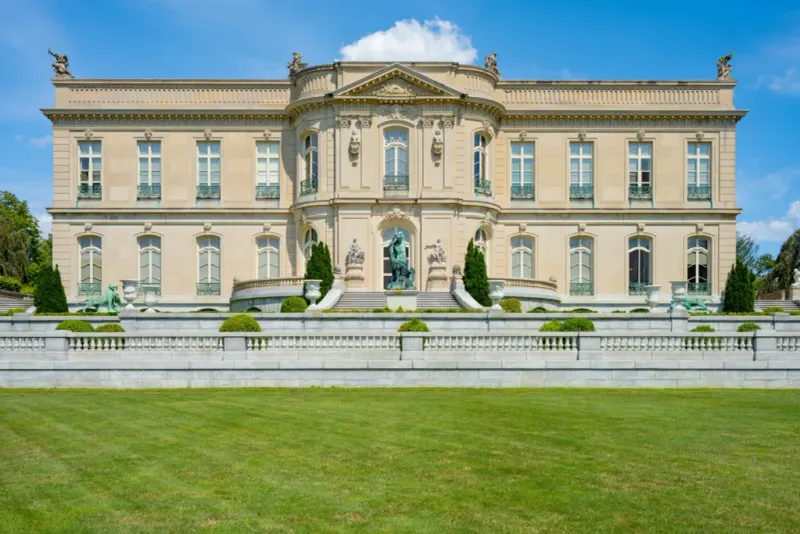
Coal baron Edward Julius Berwind commissioned this magnificent French-inspired château in 1901 as a summer retreat. Modeled after the 18th-century Château d’Asnières near Paris, The Elms cost a whopping $1.4 million to build – equivalent to over $43 million today!
Unlike many Newport mansions that flaunt their wealth, The Elms has a subtler elegance. The house was among the first in America with an entire electrical system and featured one of the earliest ice-makers. Behind the scenes, a complex network of coal-fired boilers and generators powered this technological marvel.
Most fascinating are the servant quarters on the third floor, where 43 staff members lived to maintain the Berwinds’ lavish lifestyle. The Preservation Society saved The Elms from demolition in 1962, preserving this stunning example of Gilded Age sophistication for future generations to enjoy.
9. Lyndhurst Mansion – Tarrytown, New York
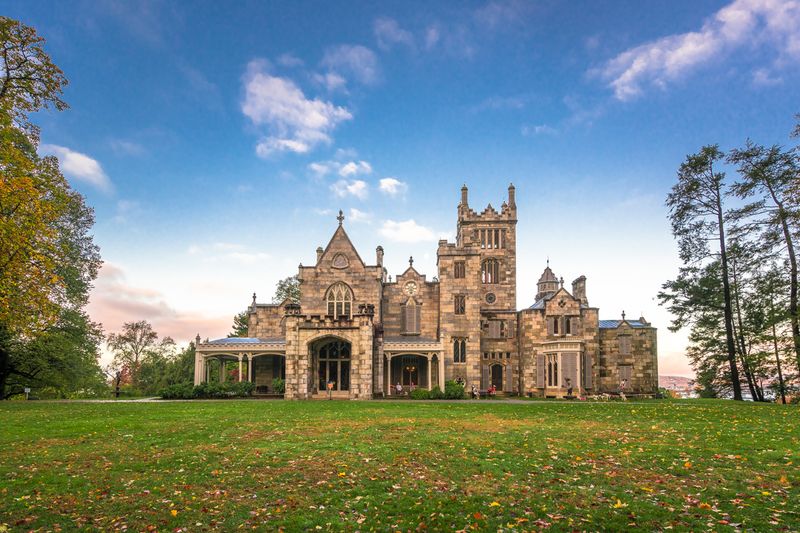
Railroad tycoon Jay Gould transformed this Gothic Revival castle into one of America’s most romantic estates after purchasing it in 1880. Perched above the Hudson River, Lyndhurst’s asymmetrical design with pointed arches, decorative tracery, and castle-like turrets makes it look like it belongs in a fairy tale.
The mansion’s interiors are just as dramatic as its exterior. Stained glass windows cast colorful patterns across marble floors, while elaborately carved woodwork frames doorways and ceilings. Gould added a magnificent art gallery with a 19-foot ceiling to showcase his collection of European paintings.
Film buffs might recognize Lyndhurst from movies like “House of Dark Shadows” and “Night of Dark Shadows.” The National Trust for Historic Preservation now maintains this architectural treasure, which offers a fascinating glimpse into Victorian-era luxury amid 67 acres of landscaped grounds.
10. Marble House – Newport, Rhode Island
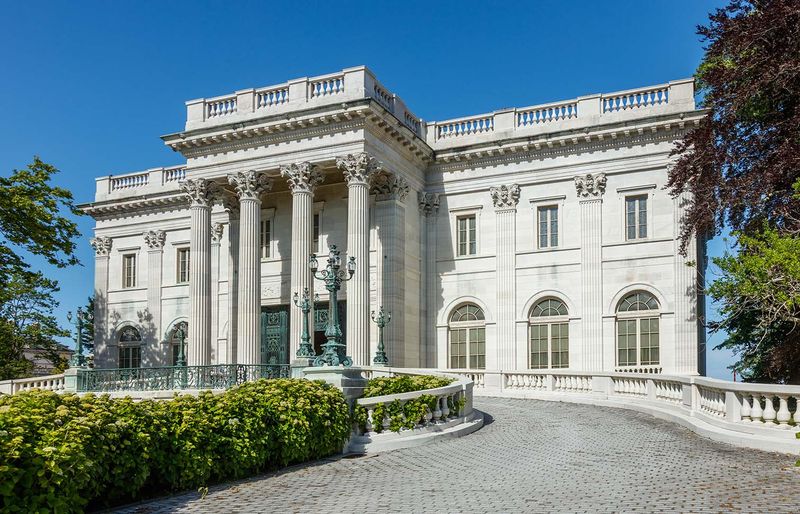
William K. Vanderbilt gave this opulent mansion to his wife Alva as a 39th birthday present in 1892. The $11 million “cottage” (over $330 million today) was inspired by the Petit Trianon at Versailles but with one extravagant difference – it contains 500,000 cubic feet of marble!
The Gold Room exemplifies the mansion’s over-the-top luxury, with walls covered in 22-karat gold leaf and furnishings upholstered in gold-threaded fabric. Alva used Marble House to host suffragette rallies on the lawn, combining extreme wealth with political activism in a way that scandalized Newport society.
After divorcing William and marrying Oliver Belmont, Alva eventually sold Marble House to Frederick H. Prince in 1932. The Preservation Society acquired it in 1963, preserving this monument to the excesses of America’s Gilded Age for over a million visitors annually.
11. Oheka Castle – Huntington, New York
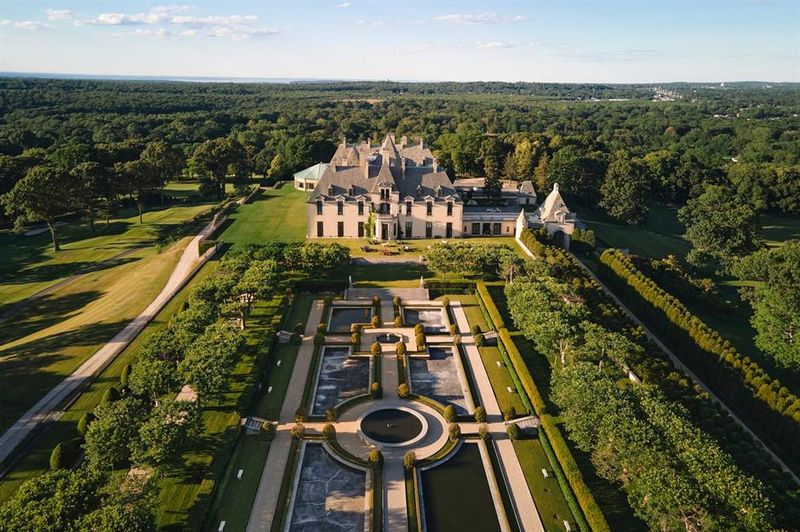
Financier Otto Hermann Kahn built America’s second-largest private home in 1919, naming it by combining the first letters of his name (Otto Hermann Kahn). This magnificent French château-style mansion boasts 127 rooms spread across 109,000 square feet and sits on 443 acres of formal gardens.
Kahn spared no expense, importing materials from around the world and hiring 200 workers who labored for two years. The estate featured indoor tennis courts, an 18-hole golf course, and a landing strip for private planes. Hollywood celebrities and royalty frequently attended Kahn’s legendary parties during the Roaring Twenties.
After changing hands several times, Oheka Castle fell into disrepair until developer Gary Melius purchased it in 1984. His $30 million restoration transformed this historic treasure into a luxury hotel and popular wedding venue that has appeared in films like “Citizen Kane” and Taylor Swift’s “Blank Space” music video.
12. Nemours Estate – Wilmington, Delaware
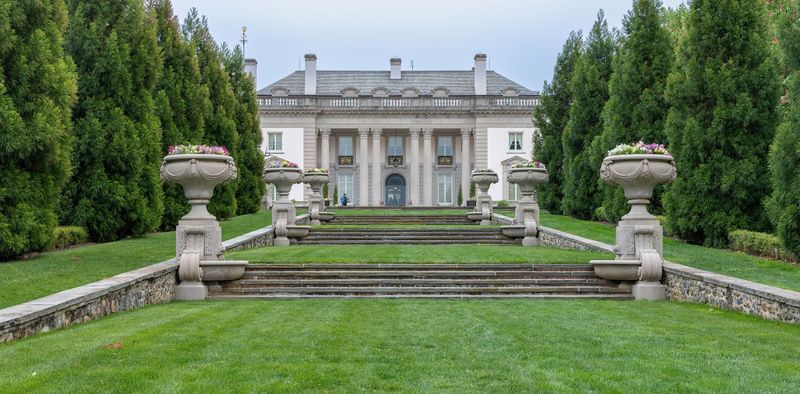
Alfred I. du Pont built this 77-room Louis XVI-style château in 1909 as a gift to his second wife, Alicia. The mansion, named after the French town where his great-great-grandfather lived, sits amid 300 acres of the most spectacular formal gardens in America.
The interior dazzles with rare marble, imported antiques, and custom-made furniture. A hidden hydraulic elevator, gold-plated fixtures, and a mechanical pipe organ showcase du Pont’s fascination with technology. The mansion’s crowning jewel is the conservatory, filled with exotic plants and featuring a ceiling painted to resemble the sky.
Most breathtaking are the gardens, modeled after those at Versailles. The main fountain shoots water 12 feet high from 157 jets, while reflecting pools, temple-like structures, and a maze garden create one of America’s finest examples of French-inspired landscape design that has delighted visitors since opening to the public in 1977.
13. Arden House – Harriman, New York
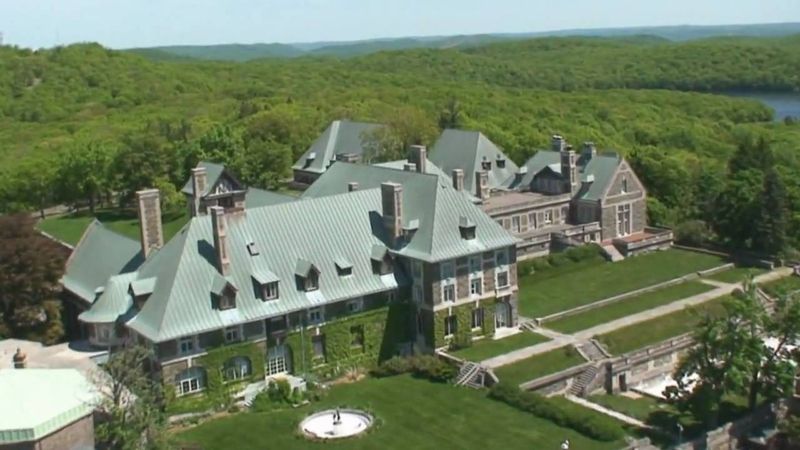
Railroad magnate Edward H. Harriman built this 100,000-square-foot mansion in 1909 atop a mountain in the Hudson Highlands. Unlike other Gilded Age showplaces, Arden House has a more rustic, castle-like appearance with natural stone walls that blend harmoniously with its wilderness setting.
The Great Hall forms the heart of the mansion, rising three stories with a massive stone fireplace and cathedral ceiling. Harriman’s son Averell, who served as governor of New York and U.S. Ambassador to the Soviet Union, inherited the estate and hosted political luminaries including presidents and foreign dignitaries.
In 1950, Averell donated Arden House to Columbia University as a conference center. The Research Center on Natural Conservation purchased it in 2007. Though not regularly open to the public, this hidden gem represents a more understated approach to wealth than many of its Gilded Age contemporaries.
14. Carolands Chateau – Hillsborough, California
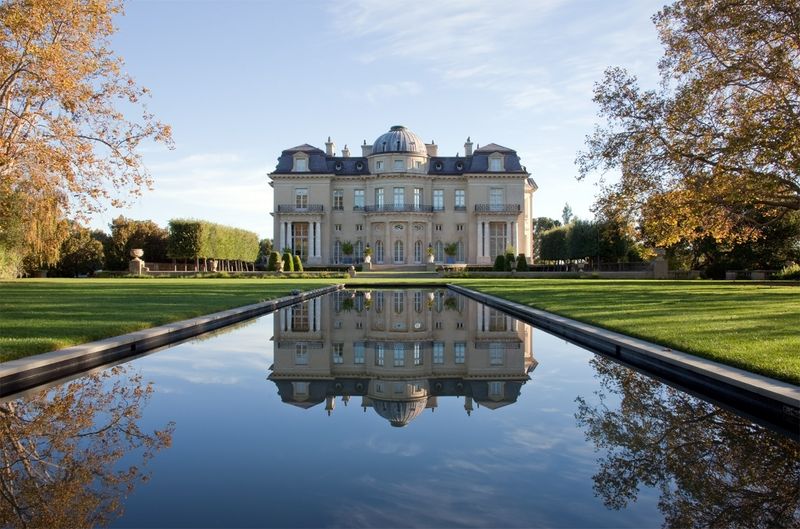
Heiress Harriett Pullman Carolan, daughter of the Pullman railroad car magnate, commissioned this 98-room Beaux-Arts masterpiece in 1915. Designed by French architect Ernest Sanson, Carolands remains one of the largest private homes in America at 65,000 square feet.
The mansion’s construction involved shipping entire rooms from European palaces across the Atlantic. Its curved grand staircase is considered one of the most beautiful in America, while the oval ballroom features hand-carved panels and mirrors from a French château. Innovative for its time, Carolands included a central vacuum system, elevator, and dumbwaiters.
After sitting vacant for decades and narrowly escaping demolition several times, Carolands was purchased in 1998 by Dr. Ann Johnson, wife of Franklin Templeton Investments chairman Charles Johnson. They undertook a $20 million restoration, and the mansion is now maintained by a private foundation that occasionally opens it for special tours.
15. Shadow Brook – Lenox, Massachusetts
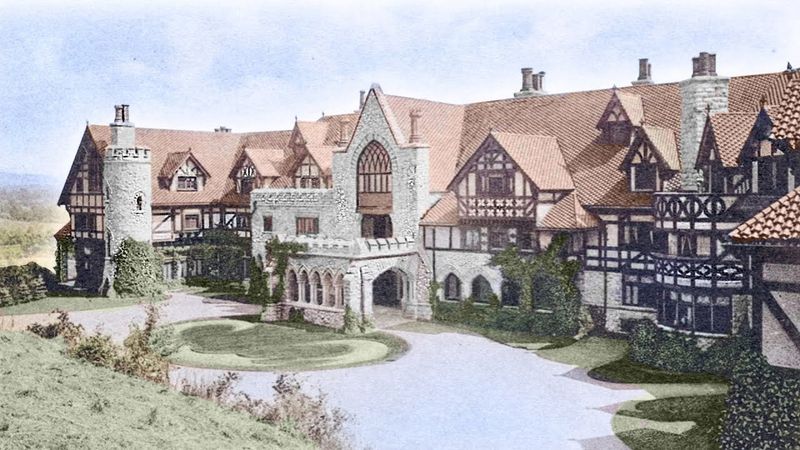
Anson Phelps Stokes, a banker and mining magnate, built what was briefly the largest private home in America in 1893. This massive 100-room Tudor-style mansion sprawled across 40,000 square feet in the Berkshire Mountains, earning its poetic name from a nearby stream.
Shadow Brook’s most distinctive feature was its great hall with a soaring 50-foot ceiling and massive stone fireplace large enough to stand in. The mansion contained a bowling alley, squash courts, and even its own power plant. Stokes lost his fortune in the Panic of 1893 and was forced to sell the estate shortly after completion.
Andrew Carnegie purchased Shadow Brook in 1917 as a summer retreat. After his death, the Society of Jesus acquired the property as a Jesuit novitiate. Tragically, the mansion burned to the ground in 1956, but the magnificent stone gates and carriage house remain as haunting reminders of this lost American palace.
16. Rosecliff – Newport, Rhode Island
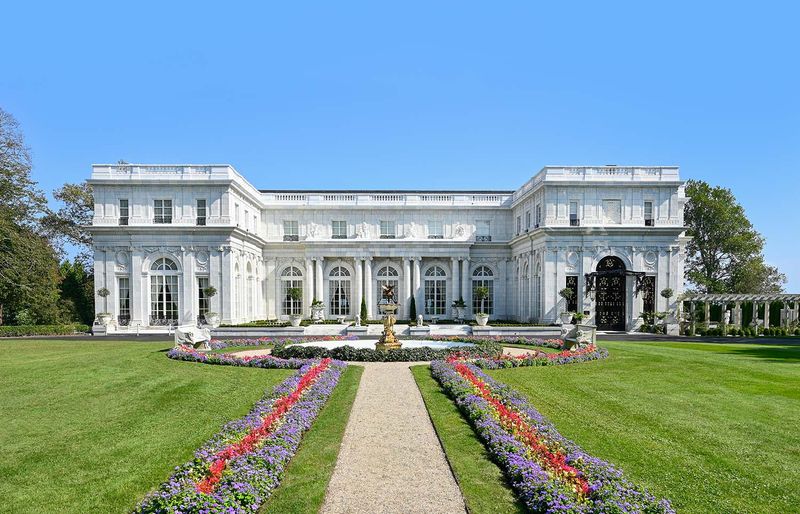
Nevada silver heiress Theresa Fair Oelrichs commissioned this dazzling white terra-cotta palace in 1902, modeled after the Grand Trianon at Versailles. Built at a cost of $2.5 million ($77 million today), Rosecliff was designed specifically for entertaining on the grandest scale.
The heart of the mansion is its spectacular ballroom the largest in Newport at 40 feet wide and 80 feet long. Here, Mrs. Oelrichs hosted her famous “Bal Blanc” where guests dressed entirely in white danced beneath silver and white decorations. Movie fans might recognize Rosecliff from films like “The Great Gatsby” (1974) and “27 Dresses.”
After changing hands several times, Rosecliff was donated to the Preservation Society of Newport County in 1971 by its last private owners. Today, its elegant ballroom remains Newport’s most sought-after venue for society weddings, continuing the mansion’s legacy as a place for celebration and spectacle.


